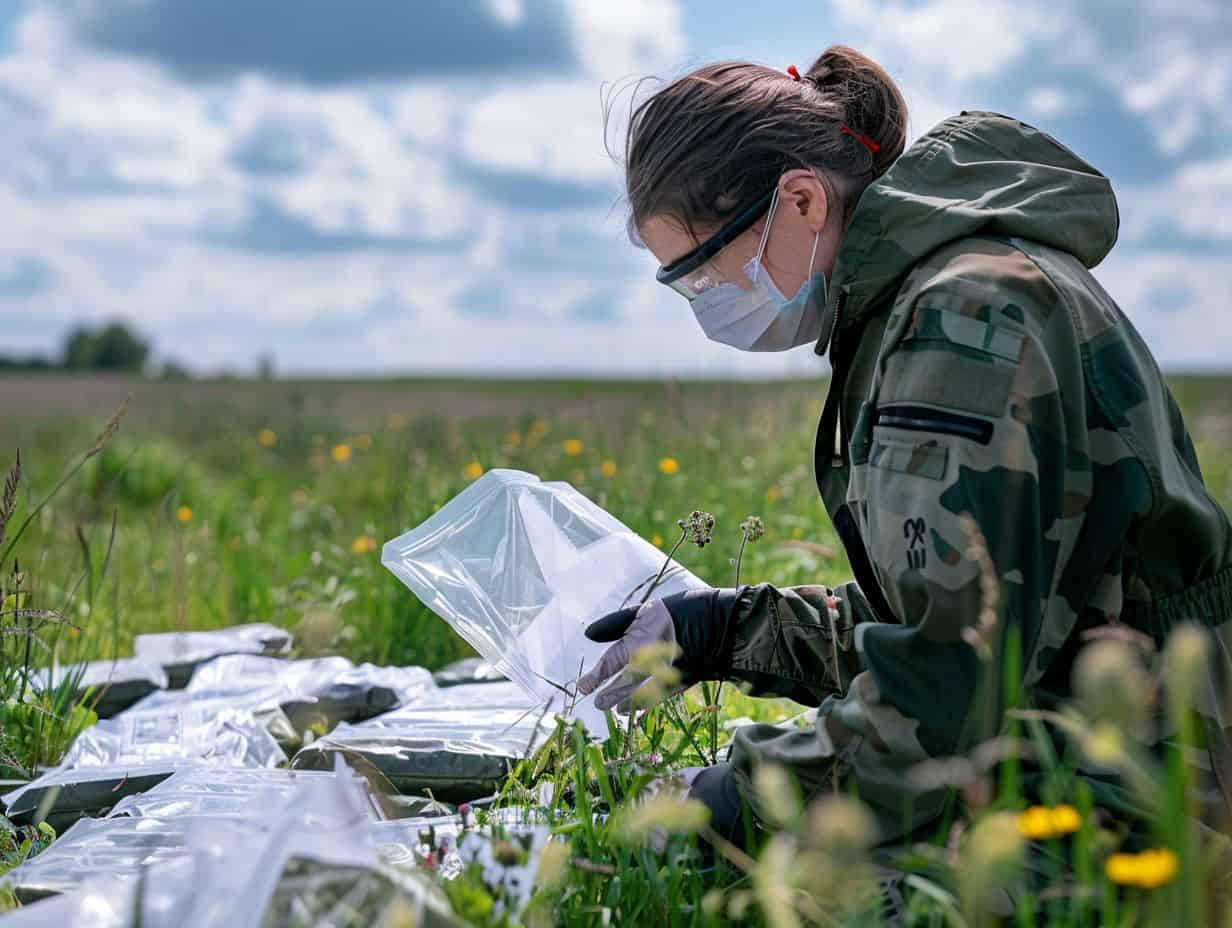Quality assurance is essential for ensuring the safety and quality of Meals Ready to Eat (MREs).
The significance of quality assurance in monitoring and maintaining the shelf life of MREs is examined.
The discussion covers the potential risks associated with poor quality assurance for MREs, factors influencing MRE shelf life, testing methods utilized in monitoring shelf life, and measures implemented to preserve shelf life.
Information on the consequences of MRE shelf life expiration, the hazards of consuming expired MREs, and how quality assurance can enhance MRE shelf life is provided.
Exploration of how quality assurance processes can be improved to more effectively monitor and maintain MRE shelf life is included.
What is Quality Assurance in the Field?
Quality Assurance in the field involves the systematic processes, guidelines, and standards implemented to ensure that products or services meet the established quality criteria and requirements. It plays a crucial role in maintaining consistency, reliability, and compliance with industry regulations.
Through quality assurance practices, organizations aim to prevent defects, minimize risks, and enhance customer satisfaction. These procedures involve thorough inspections, testing, and documentation to monitor and control quality at every stage of the production or service delivery cycle. By adhering to strict guidelines and standards, companies can identify areas for improvement, implement corrective actions, and continuously refine their processes. Quality assurance also helps in building trust among stakeholders and ensuring that products or services meet or exceed customer expectations.
In today’s competitive market, a commitment to quality assurance is essential for businesses to thrive and build a strong reputation for excellence.
Why is Quality Assurance Important for MREs?
Quality Assurance is essential for MREs (Meals Ready-to-Eat) to ensure food safety, compliance with regulations, and maintaining high-quality standards throughout the production and distribution process.
By implementing stringent quality control measures, MRE manufacturers can mitigate risks of contamination, spoilage, and other foodborne hazards. The proper handling of ingredients, packaging, and storage conditions is crucial to guaranteeing the longevity and safety of these meals. Adhering to regulatory guidelines not only safeguards consumer health but also builds trust in the brand.
Meeting and exceeding quality assurance standards in MRE production reflects a commitment to excellence and responsible manufacturing practices, ultimately benefiting both the company and the end consumer.
What are the Potential Risks of Poor Quality Assurance for MREs?
Inadequate quality assurance in MREs can result in various risks, including contamination, compromised food safety, regulatory non-compliance, and adverse health effects for consumers.
When quality assurance procedures are not followed in the MRE industry, it can lead to the introduction of harmful pathogens into the food supply chain. Issues of contamination, whether stemming from bacteria, mold, or other sources, present significant health hazards to consumers and can cause foodborne illnesses.
Lack of proper risk management measures increases the likelihood of these contaminants going unnoticed and making their way to the market. Insufficient quality assurance also complicates the process of tracing and recalling affected products efficiently, heightening the risks linked to compromised food safety. These oversights not only endanger consumer confidence but also attract regulatory scrutiny and potential legal consequences for companies operating in the MRE sector.
What is MRE Shelf Life?
The term MRE Shelf Life refers to the duration for which Meals Ready-to-Eat can be stored under specified environmental conditions while maintaining their quality, nutritional value, and safety for consumption.
Proper preservation and storage methods are essential for maintaining the shelf stability of MREs. Factors such as temperature, humidity levels, and exposure to light can have a significant impact on the shelf life of MREs. High temperatures can accelerate chemical reactions and microbial growth, potentially causing spoilage. On the other hand, storing MREs in cool, dry conditions can help extend their shelf life. Vacuum sealing and using oxygen absorbers can also assist in preserving the freshness of MREs. Understanding these factors and taking necessary precautions are crucial for ensuring the longevity of MREs.
What Factors Affect MRE Shelf Life?
Various factors can influence the shelf life of MREs, including environmental conditions, packaging materials, preservatives, storage temperature, and exposure to contaminants.
Environmental conditions are crucial in determining the longevity of MREs. Elements like temperature, humidity, and sunlight exposure can affect their quality and safety.
Packaging materials also play a significant role in preserving MRE freshness. The type of packaging, such as foil pouches or vacuum-sealed bags, can have a substantial impact on the product’s shelf life. Preservatives added during the manufacturing process help prevent bacterial and microbial growth, extending the expiration date of MREs.
Proper storage practices, such as storing MREs in a cool, dry location away from direct heat sources, can further extend their lifespan.
How is MRE Shelf Life Monitored?
The monitoring of MRE Shelf Life involves regular inspection, testing, and evaluation of the product’s quality, safety, and adherence to shelf life standards to ensure consumer satisfaction and compliance with regulations.
This monitoring process typically includes visual inspections to check for any signs of packaging damage, leakage, or mold growth. In addition, various testing methods such as sensory analysis, microbial testing, and accelerated aging tests are utilized to gauge the product’s freshness and stability. Compliance checks are crucial to verify that the MREs meet regulatory requirements and are safe for consumption.
Regular monitoring is essential as it helps in identifying potential issues early, preventing product spoilage, and maintaining high-quality standards that ultimately contribute to customer trust and satisfaction.
What Testing Methods are Used to Monitor MRE Shelf Life?

Various testing methods are used to monitor the shelf life of MREs, including sensory evaluation, chemical analysis, microbial testing, and shelf stability evaluation to ensure product quality and safety.
Sensory evaluation is important for assessing the taste, smell, texture, and appearance of MREs to identify any changes or deterioration over time. Chemical analysis involves examining the food’s composition to check for signs of degradation or chemical changes.
Microbial testing is crucial for identifying and measuring any harmful microorganisms that could compromise the product’s safety. Shelf stability assessments help predict how long an MRE can be stored before its quality declines.
Adherence to testing standards is essential for meeting regulatory requirements and ensuring consumer satisfaction.
How Often Should MRE Shelf Life be Monitored?
The shelf life of MREs should be monitored periodically based on factors like product stability, storage conditions, and anticipated expiration dates to maintain quality control and compliance with standards.
Various factors, such as temperature, humidity, and light exposure, are critical in determining the shelf life of MREs. By regularly evaluating these storage conditions and comparing them to recommended guidelines, one can accurately assess the overall quality and safety of the products.
It is important to consider the unique characteristics of different MRE varieties, as each may have specific requirements for preservation. Adhering to regulatory requirements for monitoring MRE shelf life is not only a best practice but also a legal obligation that ensures consumer safety and satisfaction.
How is MRE Shelf Life Maintained?
Maintaining MRE Shelf Life involves the implementation of rigorous quality control measures, adherence to preservation techniques, and continuous monitoring to ensure the longevity and safety of Meals Ready-to-Eat.
Quality assurance plays a vital role in this process, with meticulous checks and inspections conducted at every stage of MRE production. From sourcing ingredients to packaging and storage, each step is carefully monitored to uphold the highest standards of hygiene and freshness. Preservation methods such as vacuum sealing, use of oxygen absorbers, and temperature control are employed to prevent moisture and oxygen exposure, which can accelerate spoilage. In case of any deviations or potential risks identified, corrective actions are promptly taken to mitigate contamination and ensure the durability of the MREs.
What Steps are Taken to Ensure MRE Shelf Life is Maintained?
To maintain the shelf life of Meals Ready-to-Eat (MREs), it is important to implement measures such as proper packaging, storage under controlled conditions, adherence to quality standards, and regular quality checks.
Proper packaging is essential to protect MREs from external factors such as moisture, light, and oxygen, all of which can impact their quality. Storing MREs under controlled conditions, including specific temperatures and humidity levels, helps prevent bacterial growth and preserves their nutritional content. Adhering to strict quality standards throughout the production process is crucial to meet regulatory requirements and ensure consumer safety. Regular quality checks, which may include sensory evaluations, microbial tests, and shelf-life monitoring, are carried out to confirm product integrity and adherence to established standards.
How Can Quality Assurance Help Maintain MRE Shelf Life?
Quality Assurance is important for maintaining MRE Shelf Life by ensuring adherence to quality standards, regulatory compliance, effective contamination prevention, and timely corrective actions.
These practices are crucial in ensuring that Meals Ready-to-Eat meet strict quality requirements throughout their journey from production to consumption. Implementing rigorous quality checks during the manufacturing process helps significantly reduce the risks of contamination, thereby preserving the integrity of the food items.
Furthermore, taking prompt corrective actions when deviations from the established standards occur is vital for maintaining the quality and safety of MREs. This ensures that consumers receive products that are not only nutritious but also free from any potential health hazards.
What Happens When MRE Shelf Life Expires?
When the shelf life of MREs expires, the products may lose nutritional value, flavor, and safety, posing risks to consumers. Proper disposal procedures are crucial to prevent consumption of expired MREs.
Consuming expired MREs can lead to food poisoning and gastrointestinal issues, as the degradation of ingredients over time can promote bacterial growth. The potential hazards of consuming outdated MREs include vomiting, diarrhea, and in severe cases, even foodborne illnesses.
It is essential to adhere to expiration dates and promptly discard any expired MREs to prioritize consumer safety. Failure to follow proper disposal protocols not only risks health complications but also undermines the purpose of emergency food supplies, which are intended for sustenance during times of need.
Can Expired MREs Still be Consumed?

The consumption of expired MREs can present health risks because of potential bacterial contamination, loss of nutritional value, and changes in taste. It is recommended to dispose of expired MREs to prevent negative health consequences. Bacterial contamination in expired MREs can result in foodborne illnesses like stomach cramps, diarrhea, and nausea. The deterioration of essential nutrients in MREs over time diminishes their nutritional value, reducing their effectiveness as emergency food supplies. The alteration in taste due to prolonged storage can make their consumption unpleasant. To ensure safety, it is advised to properly dispose of expired MREs by sealing them in airtight bags and discarding them in designated waste bins or following local disposal guidelines.
What are the Risks of Consuming Expired MREs?
The consumption of expired MREs can pose various risks, including foodborne illnesses, digestive issues, nutritional deficiencies, and potential food poisoning due to contamination or spoilage.
Food safety experts stress the importance of avoiding the consumption of Meals Ready-to-Eat beyond their expiration dates to reduce the likelihood of becoming ill. Once an MRE surpasses its expiration date, the risk of harmful bacteria growth significantly increases, which can endanger one’s health. The breakdown of essential nutrients in expired MREs also reduces their nutritional value, potentially leading to deficiencies. Consumption of contaminated or spoiled MREs can have negative effects on the digestive system, causing discomfort and possible long-term health consequences.
How Can Expired MREs be Properly Disposed of?
The proper disposal of expired MREs involves securely sealing the packaging, labeling them as expired, and disposing of them in designated waste disposal areas to prevent contamination and accidental consumption. It is essential to ensure that the packaging is intact and sealed properly to avoid any leakage of potentially harmful substances.
By clearly labeling the MREs as expired, it helps to distinguish them from fresh items and alerts individuals to avoid consumption. When disposing of expired MREs, it is recommended to follow local regulations and guidelines for waste disposal to minimize environmental impact. Responsible disposal practices not only protect consumers from potential health risks but also contribute to maintaining a clean and safe environment.
How Can Quality Assurance Improve MRE Shelf Life?
Quality Assurance processes can improve MRE Shelf Life through the implementation of strict quality control measures, monitoring protocols, corrective actions, and continuous improvement practices. This comprehensive quality assurance approach includes thorough inspections of raw materials, production processes, and finished products.
Early identification of potential issues allows companies to proactively address deviations from quality standards and swiftly implement corrective measures. Effective monitoring strategies, like regular testing and analysis, are essential in ensuring that MREs meet stringent quality requirements.
Continuous improvement practices help companies adapt to changing industry standards and consumer preferences, promoting a culture of excellence in food safety and quality assurance.
What Changes Can be Made to Improve MRE Shelf Life?
Improving MRE Shelf Life may involve upgrading packaging materials, enhancing preservation techniques, optimizing storage conditions, and implementing advanced quality control measures to extend the product’s longevity and quality.
One effective strategy to prolong the shelf life of Meals Ready-to-Eat is to explore innovative packaging designs that offer heightened protection against external factors like moisture, oxygen, and light, which can degrade the food inside.
By investing in specialized barrier materials or vacuum-sealing technologies, manufacturers can create a more robust packaging solution that shields the contents from spoilage and maintains their freshness for longer periods.
Refining preservation methods such as freeze-drying or dehydration can help retain the nutritional value of the ingredients while extending the products’ viability.
Proper storage practices, including temperature-controlled environments and adequate rotation systems, are essential to prevent degradation and ensure consistency in quality.
Continuous monitoring through quality control enhancements, such as stringent testing protocols and routine inspections, can further reinforce product integrity and support extended shelf life expectations.
How Can Quality Assurance Processes be Improved to Better Monitor and Maintain MRE Shelf Life?
Enhancing quality assurance processes for monitoring and maintaining MRE Shelf Life involves integrating advanced technologies, automation, data analytics, and personnel training to ensure proactive risk management, compliance, and product quality.
By utilizing the strength of technology integration, organizations can employ real-time monitoring systems to track various factors affecting MRE shelf life, such as temperature, humidity, and storage conditions. This data-driven approach allows for predictive analysis, enabling timely interventions to maintain the integrity of the product.
Implementing comprehensive training programs ensures that personnel are equipped with the necessary skills to handle MREs effectively, minimizing errors and enhancing overall quality control. Collaborative strategies among different stakeholders in the supply chain also play a crucial role in optimizing quality assurance practices, fostering a culture of continuous improvement and innovation.
Frequently Asked Questions

What is Quality Assurance in the Field?
Quality Assurance in the Field refers to the set of processes and procedures implemented to ensure that products or services meet the required quality standards in a specific location or environment.
Why is Quality Assurance important in monitoring and maintaining MRE shelf life?
Quality Assurance is important in monitoring and maintaining MRE shelf life as it helps detect and prevent potential issues that may affect the quality and safety of the food, ensuring that it remains safe for consumption for the intended duration.
What are some key elements of Quality Assurance in the field?
Some key elements of Quality Assurance in the field include quality control measures, regular monitoring and testing, proper storage and handling procedures, and adherence to regulatory standards.
How can Quality Assurance impact the shelf life of MREs?
Effective Quality Assurance practices can help extend the shelf life of MREs by identifying and addressing potential issues before they affect the quality of the food. This can also prevent unnecessary waste and costs associated with replacing expired or spoiled MREs.
What steps can be taken to monitor and maintain MRE shelf life in the field?
To monitor and maintain MRE shelf life in the field, it is important to regularly check the expiration dates, ensure proper storage conditions, conduct regular quality control checks, and follow recommended handling and preparation instructions.
How can I ensure that my MREs are safe for consumption in the field?
Aside from following proper Quality Assurance practices, it is also important to thoroughly inspect MRE packaging for any signs of damage or tampering before consumption. If there are any concerns, it is best to seek advice from a qualified professional or dispose of the MREs.


